“Cheap reconciliation generates further injustice. True reconciliation implies accountability. True reconciliation means recognition of genocides and reparations.”
~ His Holiness Aram I, speaking at the National Cathedral earlier this month
2015 marks the 100th anniversary of the Armenian Genocide, a decades-long operation of death marches, massacres, torture, and extermination exacted against the Armenians of Turkey by the Ottoman Empire from the 1890s into the early 1920s — more than 1.5 million murdered and more than a half million exiled in all. The night of April 24, 1915, is remembered as both the height and the representative snapshot of the genocide’s horror, when hundreds of Armenian intellectuals and professionals in Constantinople were arrested during the night — imprisoned, exiled, tortured, and killed — an action repeated across many towns throughout Turkey that night.
It’s been my intent this year, mindful of the 100th anniversary of the Armenian Genocide, to learn this history in greater depth than the synopsis I’ve just stated … which is, already, more than I learned in middle & high school about the genocide. I’ve been reading, slowly, The Burning Tigris: The Armenian Genocide and America’s Response by Peter Balakian, a professor at my alma mater, Colgate University.
 But closer to my heart — and more accessible than a history volume — is Portrait of a Survivor by Florence M. Soghoian, gifted by a dear friend and sitting too long in the “waiting to be read” pile. Portrait of a Survivor is a wrenching narrative, the true stories of Ms. Soghoian’s mother’s and grandmother’s suffering through and survival of the Armenian Genocide.
But closer to my heart — and more accessible than a history volume — is Portrait of a Survivor by Florence M. Soghoian, gifted by a dear friend and sitting too long in the “waiting to be read” pile. Portrait of a Survivor is a wrenching narrative, the true stories of Ms. Soghoian’s mother’s and grandmother’s suffering through and survival of the Armenian Genocide.
How to tell you that you should read a book that includes a story of a mother’s son being beheaded on her lap … of a seminary being torched with all of its students inside … of women and children watching their family members die of starvation along death marches?
How to relate to you the impossible hope conveyed in one colorful hair ribbon, or the depth of caring manifest in a handmade afghan?
How to convince you that the stories of our collective history — especially the personal narratives of historic events that are otherwise abstractly outlined within (or omitted from) thick history books — need to be told & heard continuously so that our ears remain open and our hearts remain necessarily broken & committed to the kind of justice that comes from truth-telling?
In 1939, Adolf Hitler said, “Who after all speaks today of the annihilation of the Armenians?” One hundred years after the Armenian Genocide, I encourage you to speak of it — but first, to hear of it — through stories like Portrait of a Survivor that have been passed down by those who know that the story must not become silent history.

